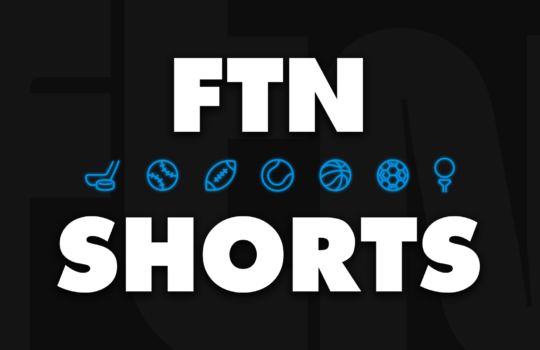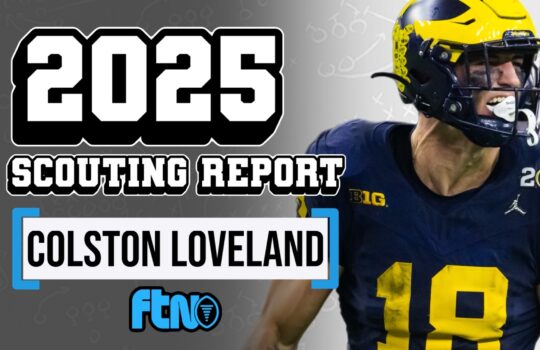

Coachspeak is heroin-addictive, even more so in this preseason-less year. Inject positivity into the veins and fantasy drafters, in the timeless words of Timothy Leary, are sure to tune in, turn on and drop out. Shirtless pictures of hard-working, protein-shake shaped players are equally seducing. In an attempt to separate fact from fiction, steadfast opiner Brad Evans tosses in his two cents on recent eye-catching headlines in another edition of “Buying or B.S.?”
According to Pittsburgh beat writer Mark Kaboly, “It’s James Conner's backfield. It's not going to be a running back-by-committee approach"
Verdict: Buying
During this strange and bizarre offseason, Conner became an amateur lumberjack. Outside his heavily forested home he chopped wood and chucked logs to chisel his frame. It was something out of the Scottish Games, but it proved effective.
Kaboly is right, Conner’s grip on the Pittsburgh backfield is tight. Expect him to drive axes into the competition. Disagree? Take a look at his competition. Benny Snell is a classic north-south power runner equipped with the speed of a rusted Vespa. Rookie Anthony McFarland is a change-of-pace back and nothing more. And Jaylen Samuels is a multidimensional complement who isn’t capable of shouldering burdensome workloads. When healthy, Conner is the 17- to 19-touch-per-game stallion the Steelers need. It’s irrefutable. As HC Mike Tomlin stated and restated during the offseason, the local product is the featured back.
Limited by multiple physical setbacks (shoulder, knee, ankle and quad), the Steelers starter was an injury-imp favorite in 2019. Though his seven total TDs rescued what would’ve been a disastrous final line, he averaged an uneventful 46.4 rush yards and 25.1 receiving yards per game, totaling just 57.8% of the opportunity share. His standings outside the top 30 in YAC per attempt (2.75) and yards created per touch tossed kerosene on the dumpster fire.
But with Ben Roethlisberger back in the saddle and the offensive line projected to be a top-10 unit, a renewed Conner is quite attractive, especially in Round 3 or Round 4 of 12-team drafts (ADP: RB17, 32.1). A return to his enormous 83.1% opportunity share from 2018 isn’t out of the question. Even if he lands somewhere in the 65-70% range, you’re looking at a firm RB2 capable of climbing into the position's top-10. With the Giants (Week 1) and Texans (Week 3) on the docket early on, a sizzling start is very possible.
Deshaun Watson recently told ESPN.com Will Fuller is “going to ball out” this season
Verdict: B.S.
Fuller is a tease. His WR1 flirtations and explosive downfield skills seem irresistible, but date him on a regular basis and you’ll inevitably feel cold and alone. The man, who has missed 22 games since 2016, simply can’t stay healthy. One of his ligaments would likely erupt watering petunias. Watson’s comments are titillating, but trust in the receiver playing even 10 games has almost completely eroded.
When active, Fuller is often impactful. In 2017 and 2018, he finished WR31 and WR21, respectively, in 0.5 PPR scoring. Last season, however, he slid outside the WR3 ranks in 12-team per-game marks, settling at WR40. As usual, his average depth of target (14.7 yards) was noteworthy and his 27.1% red-zone percentage offered TD encouragement, but marginal success rates versus zone coverage and on short-to-intermediate routes denotes how unremarkable he really was.
Going in the same vicinity as Michael Gallup, Tyler Boyd, A.J. Green and Jarvis Landry, Fuller, at cost (WR31, 68.7), is circumventable. There are simply too many associated downsides. Teammate Brandin Cooks, available some 20 picks on average after Fuller, is the Texans receiver to target.
As noted by The Athletic, rookie Zack Moss’ immediate contributions this season “might be undersold”
Verdict: Buying.
For draftniks who are religiously devoted to combine measurements, convinced they’re the be-all-end-all when it comes to player evaluation, it’s highly recommended you don’t read any further. Moss, despite a pedestrian 29th-percentile SPARQ score and other unexciting athletic testing scores, is about to break conventional wisdom. We’ve seen this happen before. Cooper Kupp, Arian Foster and others bucked the trend while Jeff Janis and Christine Michael — revered for their godlike outputs in underwear — floundered.
Moss, similar to those disruptors before him, is about to exceed the low expectations placed upon him by those who’ve never spent a single second in a dark room crunching film. Functional eyes spin a promising story. During his storied career at Utah, Moss routinely wrecked defenses. His textbook pad level, sharp vision, squatty frame (5-foot-9, 223 pounds), tireless leg churn and between-the-tackle toughness led to three consecutive 1,000-yard campaigns. Also a terrific receiver out of the backfield, he cut defenses in various ways.
Equally important, his riveting tape is supported by analytics. No rusher tallied a higher YAC per attempt rate (4.1) at the FBS level in 2019 than Moss. Additionally, he ranked RB2 in total missed tackles forced and caught 90.3% of his targets. In other words, he’s a legit three-down workhorse.
Moss’ stock is understandably rising. Available close to pick No. 100 overall in average drafts (RB39, 96.7 ADP), he poses a major threat to Devin Singletary, who is fighting with ball security issues. It would be no surprise if the Bills feature a full-blown 50-50 timeshare to begin the season. And if he slides into a plus-Frank Gore role, he could earn a ton of fantasy critical red-zone carries. In 15 games last season, Gore ranked RB23 in total totes inside the 20. Pool it together and Moss is set to mash.
















































 New York Jets
New York Jets  New England Patriots
New England Patriots  Miami Dolphins
Miami Dolphins  Buffalo Bills
Buffalo Bills  Pittsburgh Steelers
Pittsburgh Steelers  Cleveland Browns
Cleveland Browns  Cincinnati Bengals
Cincinnati Bengals  Baltimore Ravens
Baltimore Ravens  Tennessee Titans
Tennessee Titans  Jacksonville Jaguars
Jacksonville Jaguars  Indianapolis Colts
Indianapolis Colts  Houston Texans
Houston Texans  Las Vegas Raiders
Las Vegas Raiders  Los Angeles Chargers
Los Angeles Chargers  Kansas City Chiefs
Kansas City Chiefs  Denver Broncos
Denver Broncos  Washington Commanders
Washington Commanders  Philadelphia Eagles
Philadelphia Eagles  New York Giants
New York Giants  Dallas Cowboys
Dallas Cowboys  Minnesota Vikings
Minnesota Vikings  Green Bay Packers
Green Bay Packers  Detroit Lions
Detroit Lions  Chicago Bears
Chicago Bears  Tampa Bay Buccaneers
Tampa Bay Buccaneers  New Orleans Saints
New Orleans Saints  Carolina Panthers
Carolina Panthers  Atlanta Falcons
Atlanta Falcons  San Francisco 49ers
San Francisco 49ers  Seattle Seahawks
Seattle Seahawks  Los Angeles Rams
Los Angeles Rams  Arizona Cardinals
Arizona Cardinals 










 Boston Celtics
Boston Celtics  Brooklyn Nets
Brooklyn Nets  Philadelphia 76ers
Philadelphia 76ers  New York Knicks
New York Knicks  Toronto Raptors
Toronto Raptors  Chicago Bulls
Chicago Bulls  Detroit Pistons
Detroit Pistons  Milwaukee Bucks
Milwaukee Bucks  Cleveland Cavaliers
Cleveland Cavaliers  Indiana Pacers
Indiana Pacers  Orlando Magic
Orlando Magic  Atlanta Hawks
Atlanta Hawks  Charlotte Hornets
Charlotte Hornets  Miami Heat
Miami Heat  Washington Wizards
Washington Wizards  Denver Nuggets
Denver Nuggets  Minnesota Timberwolves
Minnesota Timberwolves  Oklahoma City Thunder
Oklahoma City Thunder  Portland Trail Blazers
Portland Trail Blazers  Utah Jazz
Utah Jazz  LA Clippers
LA Clippers  Golden State Warriors
Golden State Warriors  Los Angeles Lakers
Los Angeles Lakers  Phoenix Suns
Phoenix Suns  Sacramento Kings
Sacramento Kings  Dallas Mavericks
Dallas Mavericks  Houston Rockets
Houston Rockets  Memphis Grizzlies
Memphis Grizzlies  New Orleans Pelicans
New Orleans Pelicans  San Antonio Spurs
San Antonio Spurs 










